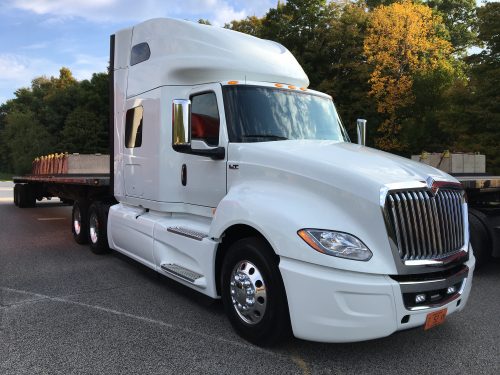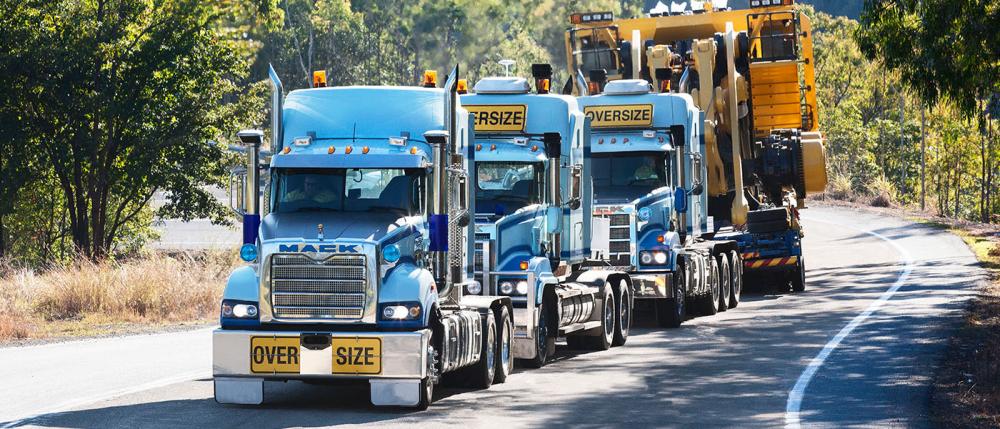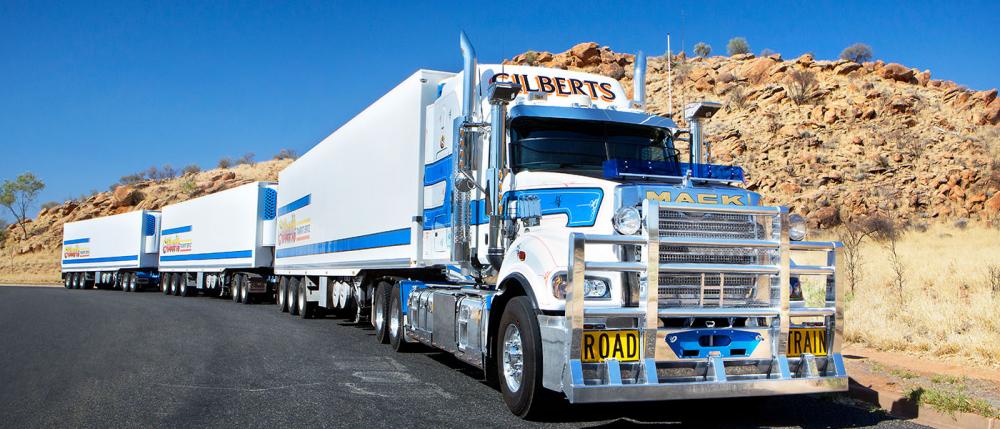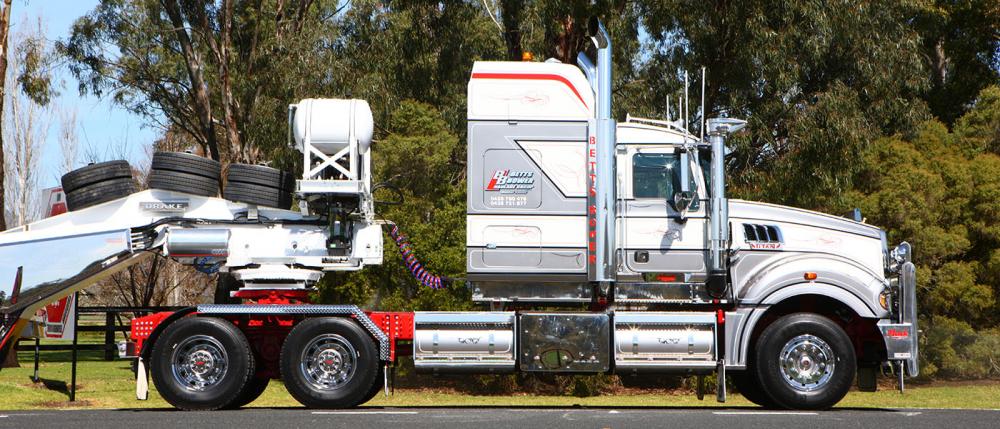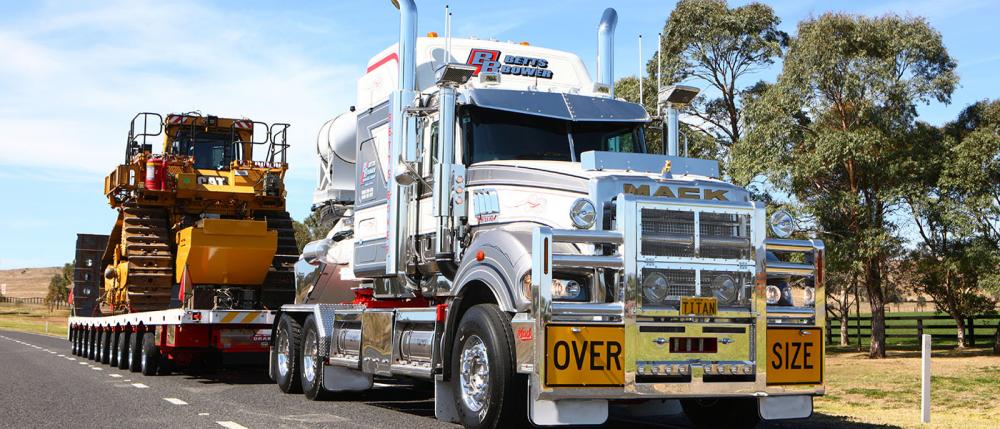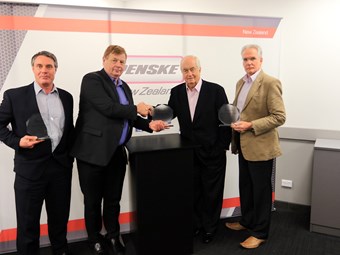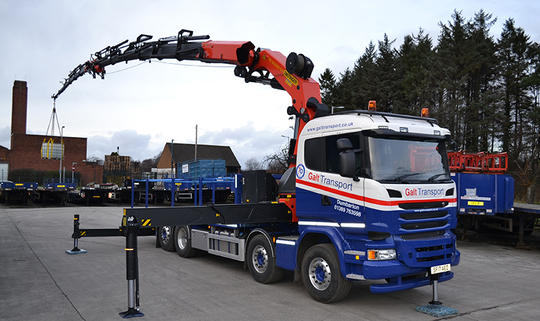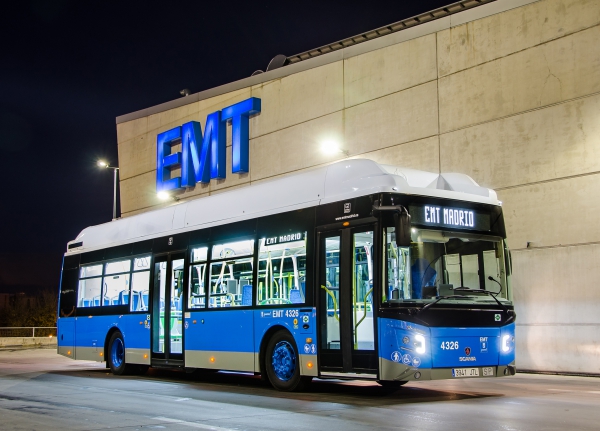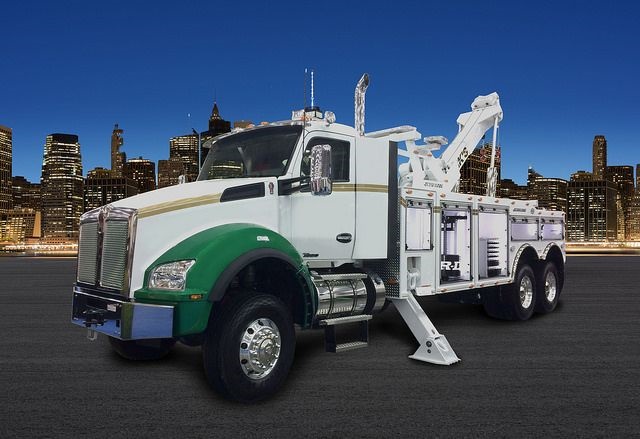
kscarbel2
Moderator-
Posts
18,875 -
Joined
-
Days Won
114
Content Type
Profiles
Forums
Gallery
Events
Blogs
BMT Wiki
Collections
Store
Everything posted by kscarbel2
-
Alkane Explores Partnership with Cummins Heavy Duty Trucking / March 8, 2017 Alkane Truck Company, a South Carolina-based assembler of alternative-fuel vehicles, is exploring a supply agreement with diesel engine manufacturer Cummins Inc., to offer clean diesel engine options for Alkane’s line of heavy-duty trucks and off-road vehicles. Pending successful engineering tests and modifications, Alkane has identified three Cummins engines to offer its customers the V5.0 engine for the Alkane Dominator [rebadged Agrale "Marrua"], the B6.7 diesel engine for the Class 7, and, once it becomes available in 2018, the X12 engine for the Alkane Class 8 heavy-duty trucks. This supply agreement would accelerate the company's operations and vision of introducing clean diesel engines to join the broad range of alternative fuel vehicles for the trucking and off-road vehicle industries in America. This supply agreement would accelerate the company's operations and vision of introducing clean diesel engines to join the broad range of alternative fuel vehicles for the trucking and off-road vehicle industries in America. “Because of the overwhelming interest of so many of our 103 dealership locations across North America, we’ve decided to include the option of a clean diesel fuel engine in our Dominator, our Class 7 and our Class 8 series trucks,” says Robert Smith, CEO of Alkane Truck Company. "Alkane and Cummins engineering teams have met in the last several weeks to develop production plans for the addition of the clean diesel fuel engines to the Alkane line of vehicles. We’re thrilled that we may be able to offer these engines to our Alkane customers in the near future.” The first of the three Cummins engine options Alkane hopes to offer customers is the V5.0, which has been engineered to combine advanced materials, the latest High Pressure Common Rail (HPCR) fuel system, Cummins VGT Turbocharger and Cummins emission control technology to produce an extraordinarily clean, quiet, and fuel efficient V-8 diesel engine. With fuel economy as a primary concern, switching from a gasoline V-8 to the Cummins V5.0 V-8 diesel reduces the cost of operation significantly; diesel fuel economy is typically better than a V-8 gasoline engine of comparable performance. Ideally suited for pickup and delivery vehicles and light- and medium-duty trucks, the V5.0 is also perfect for Alkane’s Dominator--the alternative-fuel off-road answer to the Hummer and new Land Rover Defender. Alkane is equally excited at the possibility of offering the B6.7 for its Class 7 trucks and the X12 for its Class 8 trucks. This new, more efficient 6.7L engine demonstrates up to 7% better fuel economy over the EPA 2013 B6.7 and the highest gains in key duty cycles running at lower speeds; in inner-city operations, the B6.7 had accumulated over 1.5 million test miles in multiple real-world applications prior to its 2017 launch. According to Cummins, the 2017 B6.7 will be fully capable for the introduction of stop-start technology that will yield further improvements in fuel economy in stop-and-go duty cycles. The Cummins X12, meanwhile, aims to redefine the medium-bore engine category (10L-13L) by setting a new standard for productivity in regional-haul, vocational, and intermodal truck applications. At least 150 pounds lighter than the next closest competitive engine and up to 600-pounds lighter than other medium-bore engines, the 12-liter will still deliver Alkane trucks a powerful performance from 350 hp to 475 hp and 1250 to 1700 lb.-ft. of peak torque. At just 2,050 pounds, it has the highest power-to-weight ratio of any heavy-duty engine from 10 liters to 16 liters in size, a combination of power and efficiency Alkane Truck Company hopes to be able to offer its customers in 2018 and beyond.All Content
-
Trump plan for private highway funding limited in its ability to fix U.S.’ ailing infrastructure James Jaillet, Commercial Carrier Journal (CCJ) / March 8, 2017 President Trump’s broad-level plan for bolstering U.S. infrastructure funding with investments from the private sector could buoy the country’s ability to repair overly worn highways and help stabilize the Highway Trust Fund. It also likely means more tolls for carriers, especially near urban areas, as companies seek a return on their investment. Trump’s most recent call for ramping up infrastructure funding came last week, in his first address to Congress. He reaffirmed his campaign pledge for a $1 trillion infrastructure act, saying last week it should be funded by “both public and private capital.” There’s been no shortage of talk in Washington — and nationwide — in recent years about the need to revive the country’s exhausted Highway Trust Fund. The U.S. spends about $15 billion more from the HTF than it takes in each year, says Joung Lee, policy director for the American Association of State Highway and Transportation Officials (AASHTO). “We’re going to need an additional $110 billion in the next 10-year window just to stand still,” Lee says. “But obviously our infrastructure needs are such that current funding levels are nowhere near enough.” The Highway Trust Fund has used gas and diesel taxes to fund U.S. road projects since the 1950s. However, Congress hasn’t raised the gas tax since 1993, and inflation has caused current fuel tax rates to lag far behind the country’s spending needs. Greater fuel efficiency of modern vehicles also contributed to the HTF’s waning revenue stream. Some groups, like the American Trucking Associations, contend simply raising per-gallon tax rates on diesel and gasoline would help solve the problem, but lawmakers in Washington have been reluctant to take what they believe would be an unpopular step. How much can private money fill the highway funding void? Not as much as Trump and other advocates for privatization might hope. “I don’t have a percentage, but I would say just as an estimate it would be much less than 10 percent,” says Greg Cohen, head of the Highway Users Alliance. “Private investment can handle some big new projects, but much more of course needs to be done to get the current system up to a state of good repair and to protect our commerce corridors across the country.” Cohen says Congress might use likely looming bills on tax reform to direct more public money to highways. “Advocates for that should not give up and assume it’s all tolls and public-private partnerships,” he says. Trump pledged during his 2016 campaign to take the approach he asked Congress for last week: Incentivizing private companies to invest in U.S. infrastructure with cheap financing and tax breaks. Private financiers would also be incentivized by the opportunity to turn a profit off their investment, particularly on high-traffic roadways heading in and out of cities. “Tolls are the only way to provide the revenue stream to interest the private sector in the way President Trump has broadly laid out,” says Stephanie Kane, spokesperson for the Alliance for Toll Free Interstates. “The good thing about using private sector funding is that they take on the risks. But if the money is not coming from the government, it’s going to need to come from somewhere,” she said. ATFI will push for funding alternatives that won’t prompt an uptick in tolled roads, Kane says. The group is adamant about retaining the federal ban on tolling existing Interstate lanes. “There’s no one silver bullet option for transportation funding, but tolls are the worst of those options,” Kane says. A “blend of funding” mechanisms is needed to solve the country’s infrastructure problem, she adds. Other groups see private investments in U.S. highways as a means of shoring up the country’s dire need for action on the issue, even if it means more tolls. AASHTO’s Lee, for instance, says options for private funding should be part of the discussion, even if they’re limited in their ability to stabilize the Highway Trust Fund. Public-private partnerships “are certainly an option and we certainly don’t want to preclude them as a tool for funding and financing approaches,” he says. “But P3s can only address a small spectrum. They would not be applicable beyond certain projects.” Such projects, Lee says, include “signature projects” — those that are large, expensive and risky endeavors, and mostly in and around metro areas. “We still need a robust public funding backstop, whether at the federal level or the state level,” Lee says. Though the U.S. has traditionally leaned on public dollars for its highway system, that’s not the case in other countries, including European countries with robust highways and trucking industries. These systems could provide a case study for how the U.S. handles greater privatization of its infrastructure, says Pat Jones, director and CEO of the International Bridge, Tunnel and Turnpike Association. “Our desire to spend on infrastructure far exceeds the available money,” Jones says. “I think the Trump team is wise to put all options on the table, including private investment.” Countries like France, Italy and Spain, among other European nations, have relied heavily on tolls to support highways, Jones says. “Operating and maintaining top-level super highways in those countries is as commonplace to them as having a tax-supported interstate system is to us,” he says. Still, private investment alone isn’t enough in the U.S., Jones says. “We’re going to need significant federal investment that would come from taxes or borrowing or some other form.” Jones also says toll-supported projects fit where traffic volume is significant and can generate enough revenue to repay investors. Rural stretches of highways, which constitute most of the country’s roads, aren’t.
-
Commercial Carrier Journal (CCJ) / March 8, 2017 Barely more than six months after its initial launch, the impact of International’s LT Series long-haul tractor is already being felt. Navistar Chairman President and CEO Troy Clarke says more than 5,000 orders have been placed for the truck that will phase out the company’s ProStar this year, adding that about 2,500 of them were delivered in the last three months. Clarke says the LT Series has also helped unlock the doors of several large private carriers, and quoting activity is on the rise. “We’ve got customers talking to us who haven’t talked to us for the better part of this decade, and they are interested in not just our story, but they are interested in what our products can do for their business,” he says. “For instance in 2016, we quoted 20 of the Top 50 customers in the market. With the largest customers, we quoted 20 percent more of them than we did the previous year. We got awarded 50 percent more than we did the previous year.” Clarke says he expects order intake for LT trucks equipped with the Cummins X15 engine to continue to exceed comparable ProStar figures for prior years, and is hopeful the launch of the company’s new 12.4 liter engine will be timed with a mid-year recovery in truck demand. “We’ve really been kind of non-existent in that 13-liter segment and it has remained 50 percent – and growing – of the on highway market,” he says. “Interest in our new LT product is up. I was at TMC last week and definitely there were people in and out of the truck all the time with very favorable comments. And these are the people who really make buying decisions and maintenance decisions. So we are very excited about that.” .
-
Sold! GM offloads Opel onto PSA Peugeot Citroen
kscarbel2 replied to kscarbel2's topic in Odds and Ends
Volkswagen rejects FCA’s merger overture Reuters / March 8, 2017 Fiat Chrysler boss Sergio Marchionne on Tuesday said that European market leader VW would be hardest hit by PSA Group's purchase of Opel, which will create a stronger European No. 2, and the pressure could prompt VW to sit down with FCA. But VW chief Matthias Mueller was quick to rebuff the overtures, saying his company had enough on its plate already as it battles to recover from a diesel emissions scandal. "We are not ready for talks about anything ... we have other problems," he said at the Geneva auto show on Wednesday. Mueller's rejection follows a similar snub from GM, after Marchionne said the U.S. company remained his favorite merger candidate despite its decision to exit Europe by selling Opel and having rebuffed FCA's approaches several times already. "We weren't interested before and we're even less interested now," GM President Dan Ammann said in Geneva. A combination of VW and FCA could in theory create a European market leader with a share of around 30 percent, give VW a strong foothold in North America through FCA's Chrysler operations and fix FCA's lack of scale in Asia. But the combination could also mean thousands of job losses that unions and politicians from Italy to Germany would strongly oppose. Mueller also stressed scale was not a priority for VW. "In my opinion, size does not matter," he said. "I have always said volume is not our sole goal. We want to be a successful manufacturer in every way." -
Once upon a time, we actually enjoyed privacy
kscarbel2 replied to kscarbel2's topic in Odds and Ends
-
Once upon a time, we actually enjoyed privacy
kscarbel2 replied to kscarbel2's topic in Odds and Ends
FBI's James Comey: 'There is no such thing as absolute privacy in America' The Guardian / March 8, 2017 FBI director’s assessment deepens privacy concerns raised by the details of CIA tools to hack consumer electronics for espionage, published by WikiLeaks “There is no such thing as absolute privacy in America,” the FBI director, James Comey, has declared after the disclosure of a range of hacking tools used by the CIA. Comey was delivering prepared remarks at a cybersecurity conference in Boston, but his assessment has deepened privacy concerns already raised by the details of CIA tools to hack consumer electronics for espionage published by WikiLeaks on Tuesday. “All of us have a reasonable expectation of privacy in our homes, in our cars, and in our devices. But it also means with good reason, in court, government, through law enforcement, can invade our private spaces,” Comey said at the conference on Wednesday. “Even our memories aren’t private. Any of us can be compelled to say what we saw … In appropriate circumstances, a judge can compel any of us to testify in court on those private communications.” . -
Perhaps we have a misunderstanding again. I wrote that their national health care worked great. I didn't comment on whether the countries were "great". Sweden has national health care and it works great. I appreciate and respect your thoughts, but once more respectfully, I think you're out of line to tell me where I should go live. Good day sir.
-
Once upon a time, we actually enjoyed privacy
kscarbel2 replied to kscarbel2's topic in Odds and Ends
Daily Mail / March 8, 2017 CIA hackers have learned how to adopt the 'fingerprints' of other intelligence services allowing them to carry out 'false flag' attacks. WikiLeaks, which yesterday released thousands of documents revealing how intelligence services could break into phones, computers and TVs, said the CIA was able to frame foreign spies and hackers for its own operations. The false flag allegation could be seized upon by Russia's government, which has denied reports by the FBI and CIA that it interfered with last year's presidential election to get Donald Trump elected. WikiLeaks says UMBRAGE, a sub-group of the CIA's Remote Development Branch, has collected in-depth data on hacking techniques used by other powers, which could include Russia and China. These techniques can be used to give the impression other parties are guilty of carrying out hacks which are in fact the work of the CIA. WikiLeaks founder Julian Assange has previously said he is '1,000 per cent' certain that Russia did not carry out hacking operations during the elections. A statement from WikiLeaks likened finding hacking culprits to catching a murderer, and said 'fingerprinting' could lead investigators in the wrong direction. It said: 'The CIA's hand crafted hacking techniques pose a problem for the agency. Each technique it has created forms a "fingerprint" that can be used by forensic investigators to attribute multiple different attacks to the same entity. 'This is analogous to finding the same distinctive knife wound on multiple separate murder victims. The unique wounding style creates suspicion that a single murderer is responsible. 'As soon one murder in the set is solved then the other murders also find likely attribution.' The statement continued to state that the CIA has collected information on techniques used by other nations, including Russia. It said: 'The CIA's Remote Devices Branch's UMBRAGE group collects and maintains a substantial library of attack techniques "stolen" from malware produced in other states including the Russian Federation. 'With UMBRAGE and related projects the CIA cannot only increase its total number of attack types but also misdirect attribution by leaving behind the "fingerprints" of the groups that the attack techniques were stolen from. 'UMBRAGE components cover keyloggers, password collection, webcam capture, data destruction, persistence, privilege escalation, stealth, anti-virus (PSP) avoidance and survey techniques.' -
Like the mattress industry, healthcare and pharmaceuticals has for decades in the US been a scam. The margins earned can be fairly called criminal. As far as Head Start*, I know nothing about its success/history. But I would say, it's generally better to solve the cause of a problem than to spend money supporting the problem. * Head Start is a program of the United States Department of Health and Human Services that provides comprehensive early childhood education, health, nutrition, and parent involvement services to low-income children and their families.
-
Trade Trucks AU / March 8, 2017 Penske Commercial Vehicles (PCV) celebrates MAN’s return to number one in the New Zealand 10,000kg plus bus and coach market segment with a 25% share of 2016 sales. A return to number one in the bus and coach market capped off an exceptional year for MAN, selling 115 total chassis. PCV also sold 137 MAN trucks in the 10,000kg plus truck market, which, when combined with buses resulted in a total of 252 chassis sold for the year. This combined total placed MAN in first place in the premium market, and in third place in the total market for the combined truck and bus segments (10,000 kg plus). The year culminated with the receipt of multiple MAN Truck & Bus awards where PCV New Zealand scooped almost half the accolades for the Asia Pacific region receiving the ‘Best Improvement’, ‘Best Bus Performance’ and the overall ‘Best Importer’ awards. Penske Commercial Vehicles New Zealand General Manager, John Keenan, was delighted with the year noting that the awards reflected the increasing presence of the MAN brand in New Zealand. "We have seen significant growth in MAN products in recent years," said Mr Keenan. "Underlying that growth is a premium quality, German-engineered product that is performing very well in many applications around New Zealand. "We have now set our sights firmly on being the number one premium brand in New Zealand for trucks to match our achievement in the buses. "It’s great to have both our recent accomplishments, and the significant investment Penske has made in New Zealand, recognised by MAN in Germany. "MAN has been represented in New Zealand since 1968 and will celebrate its 40th anniversary next year. Our focus is to keep MAN in a leading position and translate this long market history into tangible benefits for our customers." .
-
I'm sorry. You misunderstood me. I wrote: It's embarrassing that in the year 2017, the greatest country on earth does not provide national health care. Instead, we enjoy the highest prices for health care in the world. Sweden has national health care and it works great. Even China has national health care. In other countries, the cost of an MRI is just a fraction of that in the US, with the latest equipment. Rather than paying US$3500, you pay $120. The entire U.S. health and pharmaceutical industries is a government-supported scam. Most who has spent time overseas know what I am speaking of. Which is to say, the U.S. does not offer national health care, and I was speaking of other countries that do.
-
Commercial Motor / March 7, 2017 Dumbarton-based Galt Transport has boosted its loading and delivery services with the addition of four Scania R-series trucks, two of which feature the firm’s longest reaching truck-mounted cranes. The four trucks were supplied by Scania Truck and Bus Renfrew. There are two artic Scania R490 and two rigid R450 units, all equipped with Palfinger cranes. The two 8x2 rigid vehicles with PK65002-E cranes feature a hoist attachment that can lift 3.2 tonnes to a distance of 16.6m. The addition of a fly jib means loads of up to 0.8 tonnes can be lifted to a distance of 28m. This weight and distance can also be achieved at a distance of 12m from crane centre with the ability to lower the load straight down to ground level with the hoist. The units also have a stabiliser installed at the front of the vehicle to give greater support to the crane when operating over the front of the cab, when the fly jib is in operation. Operations director Andrew Galt said: “These new eight wheelers combine durability with payload capacity. "The fly jib not only gives the vehicle a greater working radius but also gives the crane further articulation allowing items to be lifted on to roofs more easily. "The hoist will allow items to be lowered straight down, which is another advantage of this crane specification.” The new additions bring the total number of vehicle-mounted cranes in Galt’s fleet to 28 in an overall fleet of 60 trucks and more than 100 trailers. The family firm, which celebrates its 70th anniversary this year, specialises in truck-mounted crane hire, abnormal loads, container handling, dangerous loads and driver training. .
-
IRU News / March 7, 2017 India’s Cabinet, chaired by Prime Minister Shri Narendra Modi, has approved the country’s accession to the UN TIR Convention, the global standard for international freight customs transit. This milestone decision will facilitate goods transport and transit, putting India and her neighbours at the centre of efforts to boost overland trade and regional integration across South Asia and beyond. In the light of the recent Motor Vehicles Agreement to improve cross-border transport between Bangladesh, Bhutan, India and Nepal, the government’s decision on TIR will fast-track the region’s potential to become a productive trade hub. TIR will also be critical in helping India implement the World Trade Organization’s Trade Facilitation Agreement, which entered into force last month. IRU Secretary General, Umberto de Pretto, commented, “This landmark decision puts India firmly on the road to adopting harmonised global transport standards. India will soon reap the benefits of more efficient and faster freight transit, boosting trade and helping businesses across the country prosper.” The streamlined international system for the movement of goods by road and other modes will, in particular, enhance India’s International "North-South" Transport Corridor, a key trade route between Central Asia and the Commonwealth of Independent States in the north, and southern ports in India and beyond, such as Chabahar in Iran. Accession to TIR will secure customs duties and taxes and provide a robust guarantee mechanism, reducing trade transaction costs, facilitating higher growth of intra-regional and inter-regional trade. The TIR system requires minimal manpower and facilities – other than that for checks on seals and the inspection of load compartments or containers, reducing transit delays and congestion at border crossings. This saves significantly on transport costs, leading to increased competitiveness and growth. TIR’s “single transit document” also significantly reduces the risk of presenting inaccurate information and only approved transporters and vehicles are allowed to operate.
-
Scania Group Press Release / March 7, 2017 As part of the complete bus renewal program for the Spanish capital Madrid, Scania will deliver 160 natural gas city buses. The municipal transport company, EMT Madrid, will take delivery of 80 new buses this year with another 80 buses added to the fleet in 2018. This order is in addition to the 46 Scania gas buses ordered last year. The City of Madrid has initiated an ambitious program to improve air quality and reduce carbon emissions with the stated goal to ban diesel by 2025. Half the EMT fleet of more than 1,500 buses is already natural gas powered and with the scheduled deliveries that share will be even higher. “Thanks to lower carbon emissions and noise reduction, interest in gas-fuelled operations has surged worldwide,” says Anna Carmo e Silva, Head of Buses and Coaches at Scania. “The Scania buses with the acclaimed Euro 6 gas engine is comparable in performance to a diesel engine. It is therefore an increasingly popular option, especially among European operators.” The 12-metre low floor buses will be bodybuilt by Castrosua. .
-
Dagens Industri / March 7, 2017 Navistar yesterday reiterated our forecast that the market for heavy trucks in North America will reach 190,000 to 220,000 units in 2017, which in this case would mean a decrease from last year when the market is estimated to have amounted to 226,800 vehicles. It is clear from Navistar's presentation material for the telephone conference on the interim report which began at 15 o'clock Swedish time Tuesday. This compares with the U.S. industry analyst's forecast for 2017 of 183,300 heavy trucks.
-
MAN SE Press Release / March 7, 2017 MAN Engines will present a selection of products from its engine range for construction machinery and technology, as well as for power generation, at the IFPE fair in Las Vegas in March 2017. As such, the engine department of the German commercial vehicle manufacturer MAN Truck & Bus is signaling its intention to significantly expand its business as an engine supplier for off-road applications and energy production/ generator sets in the American market. MAN Engines develops, produces, and sells a wide range of efficient diesel and gas engines, as well as axles and transfer cases, around the world for extremely varied applications in many industries. MAN Engine’s motivation for becoming more active in the USA is based on its existing access to the market, which it has enjoyed for more than twenty years through its subsidiary, MAN Engines & Components, Inc. (MEC) in Pompano Beach, Florida. “Thanks to our quality products developed in Germany and our decades of market expertise as an American company, we see ourselves as the perfect engine partner for all OEM manufacturers interested in volume business,” comments Ricardo Barbosa, CEO of MEC. The company’s commitment will be further underlined in future by additional personnel capacity. Jürgen Haberland, an industry expert and currently Head of Off-Road MAN Engines, will further develop the company’s business with engines and components in the Americas in his role as Business Development Manager in the USA. Years of experience in many different applications MAN Engines has been involved and well-established in many applications in the USA for many years. For example, just a few weeks ago, Viking Yachts, an American manufacturer of luxurious sportfishing boats, took delivery of the 2,000th V engine; these engines have power outputs of up to 1,397 kW (1,900 HP). MAN Engines in the USA has also been producing front and rear axles for the bus manufacturer New Flyer for many years. As the market leader in this field, MAN Engines has approximately 2,000 axles on the road with New York Transit (New York City transportation system) alone. MAN has a long history in agricultural technology, and its products are currently used by customers such as Claas, Fendt, and Krone in large agricultural machinery with high power needs. MAN engines are also being used in the USA thanks to an earlier development partnership in the field of engine technology with a well-known manufacturer of construction machinery. In the combined heat and power generation sector, MAN Engines has for many years been the market leader in its power range when it comes to gas engines used in cogeneration power plants. In addition, the engine manufacturer is also involved in powerful gas generator sets, thanks to an ongoing collaboration with the American company Generac Power Systems. Solid foundation thanks to commercial vehicle business As a division of MAN Truck & Bus, MAN Engines benefits considerably from the large-scale production experience which this leading European commercial vehicle manufacturer can call on with regard to sophisticated components and the latest technology. “The engines used in large construction and agricultural machinery are always based on the fundamental technology used in commercial vehicles. In the mid-term, the increasing technology requirements will only be able to be fulfilled with large production volumes. Therefore, a solid business model with commercial vehicles always serves as the foundation for the mid-term development of new, modern, and future-proof engine series,” comments Jürgen Haberland, Head of Off-Road MAN Engines. In addition, the many years of experience with engines, as well as the in-house development, design, and production work at the International Engine Competence Center in Nuremberg, ensure the high quality and reliability expected of MAN engines. Wide power range for off-road applications Building on this strong foundation, MAN Engines provides the required technology and products for new partnerships in the field of construction site and mining vehicles. MAN Engines covers a power range from 294 to 816 kW (400 to 1,110 HP) with the three engine series D2676, D3876, and D2862 with 12.4, 15.2, and 24.2-liter capacities. The engine dynamics are adjusted to match the particular application using wastegate turbocharging or variable turbine geometry. In this way, MAN diesel engines provide sufficient charging pressure and dynamics for wheel loaders, excavators, dump trucks, and mobile cranes, even at low revs in the efficient engine speed range. Flexible and efficient compliance with the EPA Tier 4 final emissions standard The company is able to meet both current and future emissions standards due to its many years of experience with exhaust gas aftertreatment systems from its own commercial vehicles and the large-scale production of industrial engines. “Our MAN engines need no more than an SCR catalytic converter combined with optimized combustion and exhaust gas recirculation inside the engine to comply with the US EPA Tier 4 final and EU Step IV standards. There is no need for a diesel particulate filter and an oxidizing catalytic converter which simply take up space in the engine and add to the cost,” according to Haberland. The modular exhaust gas aftertreatment (AGN) system used enables flexible system integration for all MAN engines with a high degree of packing density thanks to its variable set-up options for components. 16 different AGN variants make it possible for machine manufacturers not only to make optimum use of the given space in applications where space is crucial, but also to increase compatibility and flexibility when fitting the engines. Gas engines for generator sets and combined heat and power generation MAN Engines also sees many potential applications for stationary gas engines in energy production and combined heat and power generation in public facilities, industrial applications, and homes. Thanks to the potential for saving energy in these applications, and the resulting cost savings, this sector offers a lot of promise. In addition to considerable experience in combined heat and power generation in the USA alone, MAN Engines also has wide-ranging experience thanks to its position as the market leader in Germany, with many thousands of installed engines. As such, the company offers the corresponding product portfolio. MAN Engines covers a power range from 62 to 580 kW at 1,800 rpm (60 Hz) [54 to 550 kW at 1,500 rpm (50 Hz) in Europe] with the three engine series E0834/E0836, E2676, and E3262 with 4.6/6.9, 12.4, and 25.8-liter capacities. The naturally aspirated engines are powered by natural gas and can be equipped with a three-way catalytic converter to reduce nitrogen oxide and carbon monoxide emissions. “This means we can offer our partners a very efficient and, above all, inexpensive exhaust gas aftertreatment system, which meets even very low local limit values.” says Hubert Gossner, Head of Power MAN Engines. An alternative portfolio of turbocharged, lean-burn engines based on the same engine series is available for use with natural and special gases, with power ranges from 68 to 580 kW at 1,800 rpm (60 Hz) [58 to 550 kW at 1,500 rpm (50 Hz)]. In order to meet current and future emissions regulations, MAN also uses the space-saving modular exhaust gas aftertreatment system (AGN) here. It is already being used successfully in mobile applications and has proven itself there in engine compartments with limited space. MAN Engines at the IFPE in Las Vegas MAN Engines will present itself and a selection of current products at the International Fluid Power Exposition (IFPE), which is taking place at the same time as the ConExpo/ConAGG in Las Vegas from March 7 - 11, 2017 in South Hall 3, stand S83541.
-
Kenworth to display new T880S mixers at 2017 World of Concrete
kscarbel2 replied to kscarbel2's topic in Trucking News
Kenworth T880S Enters Production with Strong Demand from Robust Construction Market Kenworth Truck Company Press Release / March 6, 2017 The Kenworth T880S has been a much-anticipated option for mixer body builders and their customers needing to meet the federal bridge formula. And, with T880S production commencing this week, order boards are filling up. McNeilus Manufacturing, a division of Oshkosh; and Con-Tech Manufacturing are the first customers receiving T880S chassis during this first week of production. The Kenworth T880S features a set-forward front axle, which makes it the go-to configuration for mixer customers needing to comply with federal bridge formulas. “We’re glad production is rolling, and the response has been great,” said Tom Harris, who serves as McNeilus vice president of concrete mixers. “A large percentage of our orders are for the set-forward configuration.” Kenworth is displaying seven T880 trucks, five of which are T880S models, at this week’s CONEXPO-CON/AGG show in Las Vegas. On display in the Kenworth booth (S-62939) is a McNeilus T880S with an 11-yard BridgeMaster® body destined for Ozinga Ready-Mix based in Chicago, Illinois. According to Harris, the Kenworth T880S is being spec’d in a four-axle configuration with an overall length under 40 feet. “And we’re recommending the T880S be spec’d with the PACCAR MX-11 engine, which saves our customers significant weight (400 pounds over a 13-liter engine) while supplying enough power to get the job done.” Harris said Kenworth is a preferred supplier to McNeilus and the company has always done a great job of building its trucks with the mixer market in mind. “Our customers appreciate the little things that Kenworth does to make a great mixer truck,” he said. “The cowl-mounted mirrors are an example. A driver will typically have the door open when at a job site, but they’ll also use the mirrors and that can only be done if it’s cowl-mounted.” A big fan of the T880, Harris said the bigger windshield and lines of sight are a welcome addition, “along with the ergonomics and the quietness of the cab,” he added. “The T880 is just a great truck for our market.” Also on-display in Kenworth’s booth is a T880S with Con-Tech BridgeKing® 11-yard body, which will go to Eagle Redi-Mix based in Tulsa, Oklahoma, after the show. Response in the market to Kenworth’s T880 and T880S has been “tremendous,” said Dan Welsh, president of Con-Tech Manufacturing. “The larger cab, visibility, dash layout and modern look have really caught the attention of our customers,” he explained. “They love it. We’re now seeing the pendulum swing towards orders for the set-forward configuration, and we expect about 80 percent of our Kenworth build will be for the T880S model.” According to Welsh, the quality of Kenworth and the Con-Tech body is a great match. “Quality all the way around,” he said. “That keeps our customers productive on the job site, and keeps them coming back for more of our mixers as they grow their business.” The T880S is available with a set-forward front axle ranging from 14,600 pounds to 22,800 pounds and is available with a 114-inch BBC and best-in-class 28-inch bumper setting as well as 29.5-inch and 31.5-inch bumper settings as options for dump truck, crane, or other construction applications. The bumper setting is especially important in complying with federal bridge formula where the chassis is required to stay under 40 feet in length. -
Yes Keith, the Constitution and Bill of Rights don't say anything about healthcare, a concept unknown to them in 1776. The Constitution and Bill of Rights don't say that you have to pay for U.S. streets and schools and around $50 billion in foreign aid. You may not own a car, or have children, but you pay for streets and schools. Believe me, I myself would like nothing more than to have citizens provide financial support only for the services they use (government and armed forces costs covered by all). Are you satisfied with the cost level of medical care and medicine in the US?
-
James Jaillet, Commercial Carrier Journal (CCJ) / March 7, 2017 A band of trucking industry stakeholders, including some truck and engine OEMs and the American Trucking Associations, issued a letter last week to the new administrator of the Environmental Protection Agency asking him to ensure the agency continues to support the Diesel Emissions Reduction Act program. DERA offers rebates and grants to owners of diesel-powered equipment to aid in retrofitting older engines with more modern, lower emissions technology or in replacing older equipment all together. In a March 3 letter to new EPA Administrator Scott Pruitt, 20 companies and organizations rallied for the continuation of the program, arguing it “supports domestic jobs while helping to clean the air.” “We estimate that almost three out of five diesel trucks and buses on the road today are more than ten years old and emit much higher levels of emissions than the vehicles using today’s technology. Without a program like DERA, these older vehicles will stay on the road until they wear out, increasing emissions that could be significantly reduced if replaced with newer technology,” the letter states. Pruitt, former attorney general in Oklahoma, was confirmed by the Senate in February to run the EPA under President Trump. As Oklahoma’s attorney general, Pruitt sued the EPA 14 times, saying the agency overstepped its legal bounds with implementation of programs targeting fossil fuel use. He lost 13 of the cases, and the other is still being litigated. As EPA administrator, he’s said he intends to cut the size of the EPA and scale back its regulatory reach. Last week’s letter from industry stakeholders aimed to convince Pruitt of DERA’s merits, arguing its benefits well exceed the program’s costs. More than a simple federal spending program, DERA prompts private sector spending on new equipment and equipment updates, the groups argue. “It is a completely voluntary, merit-based program. EPA estimates every $1 in federal assistance is met with another $3 in non-federal matching funds, including significant investments from the private sector,” the letter states. “EPA estimates equates to approximately $12.6 billion in health benefits — all this for an investment of only $700 million.” Signees include ATA, Caterpillar, Cummins, Navistar, the Truck & Engine Manufacturers Association and Volvo Trucks, in addition to several other prominent groups. The letter’s distribution was spearheaded by the Diesel Technology Forum. Nearly 73,000 vehicles have been upgraded or replaced under the program since its passage in Congress in 2005, the petitioners say, noting that the act received “overwhelming bipartisan support” in both chambers of Congress. Such upgrades have cut fuel usage by a combined 450 million gallons in that time period, petitioners say. “DERA provides state and local air agencies and the federal government with effective tools to allow communities struggling with deteriorated air quality to meet today’s tougher standards,” the letter reads. “The program also supports job growth and industry stability using technology invented in the U.S. and manufactured at almost entirely U.S factories.” See the full letter at this link.
-
U.S. trade deficit jumps to 5-year high of $48.5 billion Associated Press / March 7, 2017 The U.S. trade deficit jumped in January to the highest level in nearly five years as a flood of mobile phones and other consumer products widened America's trade gap with China. The result underscores the challenges facing President Donald Trump in fulfilling a campaign pledge to reduce America's trade deficits. The deficit in January rose 9.6 percent to $48.5 billion, up from a December deficit of $44.3 billion, the Commerce Department reported Tuesday. It was the largest monthly gap since a deficit of $50.2 billion in March 2012. U.S. exports edged up a slight 0.6 percent to $192.1 billion, helped by stronger auto sales. But that was swamped by a 2.3 percent surge in imports to $240.6 billion, led by mobile phones, oil and foreign-made cars. During the campaign, Trump pledged to attack America's persistent trade deficits, which he blamed for the loss of millions of good-paying factory jobs. He has threatened to slap punitive tariffs on imports from China, Mexico and other nations he has accused of trading unfairly. But economists worry that Trump's tough talk could spark all-out trade wars in which foreign nations retaliate by boosting their tariffs on American goods. White House trade adviser Peter Navarro, a long-time critic of China's trade practices, told an economists' group on Monday that reducing America's trade deficits would deliver stronger economic growth and improve national security. For January, the U.S. deficit with China increased 12.8 percent to $31.3 billion, the highest level since September. The figure reflects a big rise in imports of mobile phones, clothing, televisions, toys and games. American exporters have struggled over the past two years as a rising dollar has made their goods more expensive and therefore less competitive in overseas markets. Economists believe if the dollar stabilizes this year, export growth should rebound, reflecting in part stronger economic growth in many of America's major export markets. Andrew Hunter, U.S. economist for Capital Economics, said that the big increase in the deficit in January likely signals that trade will drag overall growth in the first quarter. But he said the impact wouldn't be as severe as in the fourth quarter, when trade trimmed growth by 1.7 percentage points. And brighter days may be ahead. "With the headwind from the dollar's prior appreciation having eased and global growth picking up quite sharply, the outlook for exports is better now than it has been in some time," Hunter said. The trade deficit is the difference between imports and exports. A rising deficit is a drag on overall economic growth because it means more products are being produced for domestic consumption from overseas. The trade deficit is expected to trim overall economic growth by around one-half percentage point this year. Many economists are looking for the U.S. economy to grow between 2 percent to 2.5 percent in 2017, up from anemic 1.6 percent growth in 2016.
-
Heavy Duty Trucking / March 6, 2017 Kenworth’s T880 is now available in an all-wheel drive configuration installed at the factory to speed delivery time and reduce costs. The Marmon Herrington MT-22 front drive axle is available in a 6x6 or 8x8 Class 8 configuration with a capacity rating up to 22,000 pounds. The all-wheel drive configuration requires a Fabco transfer case, and can be specified with Fabco’s 1-speed TC-142 or 2-speed TC-143 transfer case, depending on customer requirements. “For severe duty applications where the ultimate in traction is required, our new configuration is a welcomed spec,” said Kurt Swihart, Kenworth marketing director. “We see our all-wheel drive T880 being used in oil fields, configured as an off-road crane, in utility and construction work, or used with municipalities and fire/rescue.” For more information, click here. .
-
Navistar Loses $62 Million in its Fiscal First Quarter
kscarbel2 replied to kscarbel2's topic in Trucking News
Earnings Watch: Navistar Losses Nearly Double from Year Earlier Heavy Duty Trucking / March 7, 2017 Navistar International Corp. on Tuesday announced its financial losses in the first quarter of 2017 nearly doubled from the same time a year ago due to lower truck volume and softer Class 8 truck sales. The truck and engine maker reported a net loss of $62 million, or 76 cents per share, greater than a consensus estimate from a poll of analysts, who were forecasting a 45 cents per share loss. This compares to a first quarter 2016 net loss of $33 million, or 40 cent per share. Revenue in the most recent quarter totaled $1.7 billion, in line with Wall Street expectations, but a decline of 6% compared to $1.8 billion in the first quarter last year. The quarter marked the company’s eighth consecutive decline in quarterly revenue, according to Reuters. First quarter 2017 earnings before interest, taxes, depreciation and amortization (EBITDA) was $63 million, compared to first quarter 2016 EBITDA of $82 million. This most recent period included favorable net adjustments of $8 million, primarily resulting from a reversal of pre-existing warranty accruals. "Our results are on track with our plan for the year, and demonstrate our ability to effectively manage costs at a time of persistent Class 8 industry headwinds," said Troy A. Clarke, chairman, president and CEO. "Our order share continues to outpace our market share, which confirms our confidence in the retail share improvement to come." Truck-segment first quarter 2017 net sales decreased $105 million, or 9%, primarily due to lower core (Class 6-8 trucks and buses in the United States and Canada) truck volumes “as a result of softer industry conditions, the end of CAT-branded units sold to Caterpillar, and the sale of Pure Power Technologies, both of which occurred in the second quarter of 2016.” During the most recent quarter, Navistar’s truck segment loss increased to $69 million versus a loss of $51 million in the same period a year ago. “This was primarily driven by market pressures, the impact of lower core market volumes, and a decrease in other income due to the receipt of a one-time fee from a third party last year, partially offset by lower used truck losses, improved material costs and lower adjustments to pre-existing warranties,” the company said in a statement. Its parts-segment net sales were comparable to the prior year while its global-operations segment net sales decreased $42 million, or 46%. The Financial Services segment net revenues decreased by $5 million, or 8%, and profit decreased by $13 million, or 50%. Last week, Navistar announced the closing of its wide-ranging strategic alliance with Volkswagen Truck & Bus, which included a $256 million equity investment in Navistar by that company and the creation of a procurement joint venture and a strategic technology and supply collaboration, both of which are already up and running. The deal gives the German auto and truck maker a 16.6% stake in Navistar. Looking ahead, Navistar plans to continue to introduce new products every four to six months through the end of 2018, refreshing its entire product portfolio, while also expanding it with its re-entry into Class 4/5 vehicles through its collaboration with General Motors. In the first quarter, Navistar began customer deliveries of its new International LT Series Class 8 long-haul truck and last week unveiled its 13-liter A26 engine. Also on Tuesday, Navistar reiterated and updated its 2017 guidance: Retail deliveries of Class 6-8 trucks and buses in the United States and Canada are forecast to be in the range of 305,000 to 335,000 units for fiscal year 2017 Full-year 2017 revenues are expected to be similar to 2016 Full-year 2017 adjusted EBITDA is expected to be higher than 2016 Fiscal year end 2017 manufacturing cash is now expected to be about $1 billion, including the capital injection from Volkswagen Truck & Bus and a $250 million senior note tack-on completed in the first quarter 2017
BigMackTrucks.com
BigMackTrucks.com is a support forum for antique, classic and modern Mack Trucks! The forum is owned and maintained by Watt's Truck Center, Inc. an independent, full service Mack dealer. The forums are not affiliated with Mack Trucks, Inc.
Our Vendors and Advertisers
Thank you for your support!


